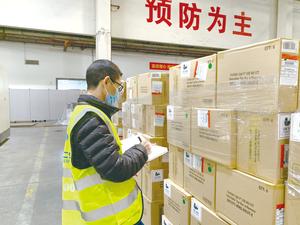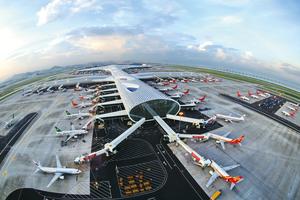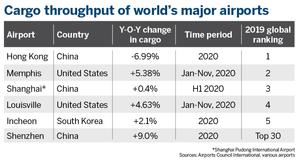As world air travel grinds to a halt amid the pandemic, Shenzhen has found a niche in the hard-hit aviation industry by embracing the new dynamism and charting a course for future growth. Li Bingcun reports from Shenzhen.
 Zhang Jinlin, a manager at Shenzhen airport’s international cargo center, inspects a warehouse at the airport in January. (PHOTO PROVIDED TO CHINA DAILY)
Zhang Jinlin, a manager at Shenzhen airport’s international cargo center, inspects a warehouse at the airport in January. (PHOTO PROVIDED TO CHINA DAILY)
When people can’t fly, cargoes can, and can fly higher.
With the Chinese mainland among the first countries to make a strong rebound from COVID-19, soaring trade calls for unparalleled support from sea and air forwarders — the latter having taken a big leap forward.
If Shenzhen airport can make a head start in cold-chain delivery, the airport should further upgrade its expertise and capacity in this area into a pivotal business
Mao Lingke, senior logistics adviser at Cainiao Global Supply Chain
The mainland’s airfreight industry has seen remarkable growth with air passenger travel still in the doldrums, driven by rigorous global demand for anti-pandemic medical supplies, and the exponential growth of e-commerce, as more people go virtual in work, shopping and entertainment under tough social distancing curbs.
The air cargo business looks set for another boost this year with the massive distribution of COVID-19 vaccines rolling out on a global scale.
Shenzhen’s Bao’an International Airport was ahead of the pack with 9 percent growth in freight volume last year — the fastest among the country’s top five air cargo airports. The growth rate is also expected to outperform most of the world’s top 10 air cargo hubs, which recorded slowing growth in the first half of 2020. Hong Kong International Airport’s cargo throughput was down 7.7 percent from previous period in the first 11 months of 2020.
New-found edge
Shenzhen airport’s robust growth holds promise in keeping its new-found edge in handling freight in post-pandemic recovery. The airport has opened eight new international routes for cargo — the biggest addition to its destinations list in seven years.
With its total annual cargo volume reaching 1.4 million metric tons, the airport ranked third in China last year. It was among the world’s top 30 in 2019. It was an opportunity identified after the initial shocks of the pandemic buffeted the aviation industry.
Zhang Jinlin, a manager in Shenzhen airport’s international cargo center, said he never expected such a dramatic change in last year’s business outlook.
In February and March 2020, the airport’s operations hit rock bottom because of the COVID-19 pandemic, forcing Zhang to work mostly from home. The turnaround came in April. He recalled that the airport apron was packed with aircraft from various countries, some of which he had never seen in his 16 years working there, including Antonov AN -124, the world’s second-largest cargo plane. Some of the aircraft were previously for military use and one company sent a fleet of six planes in one go.
From the airport, masks, testing kits and ventilators were flown to other parts of the world to help people in need. That was when the pandemic was showing signs of being brought under control in China as it raged in other places. At China’s busiest airports, including Shenzhen’s, the demand for exporting anti-pandemic supplies was acute.
 Two aircraft of European airline companies pick up anti-pandemic medical supplies at Shenzhen airport in May 2020. (PHOTO PROVIDED TO CHINA DAILY)
Two aircraft of European airline companies pick up anti-pandemic medical supplies at Shenzhen airport in May 2020. (PHOTO PROVIDED TO CHINA DAILY)
Zhang’s team worked around the clock to handle the mountain of work. He lives near the airport and, sometimes, had to be called back to work in the wee hours. Some of his colleagues living farther away have voluntarily slept at the airport to save time.
The air cargo demand remained strong last year. But what was being shipped out changed along with the world entering a new phase in its battle against the coronavirus pandemic.
First came anti-pandemic supplies, followed by cross-border e-commerce commodities, from fitness equipment to gardening tools. The demand for such items was robust in developed countries, presumably because of burgeoning “stay-at-home” economies.
Vaccines will be high up on the list too as countries place their hopes on having their populations inoculated to check the pandemic’s spread.
Wan Jianjun, deputy general manager of Shenzhen airport’s logistics department, said they’re ready to play a crucial role in meeting the huge demand in the global transportation of COVID-19 vaccines, citing the airport’s expertise in cold-chain medicine delivery and a rapidly expanding international airline network.
After Beijing and Shanghai airports, Shenzhen airport obtained the International Air Transport Association’s Center of Excellence for Independent Validators in pharmaceutical logistics in October — an internationally recognized certification of cold-chain medicine delivery. It also has a 350-square-meter cool center and three cool trailers for this purpose.
By late November, Ethiopian Airlines and Cainiao International had started the first regular international cold chain route between China and Africa, which aims to transport temperature-controlled drugs, including COVID-19 vaccines, from Shenzhen airport to Addis Ababa via Dubai.
The route can endure temperatures as low as -23 C, cold enough to handle the low-temperature storage required for most COVID-19 vaccines throughout the distribution process.
 An aerial view of Shenzhen Bao’an International Airport. (PHOTO PROVIDED TO CHINA DAILY)
An aerial view of Shenzhen Bao’an International Airport. (PHOTO PROVIDED TO CHINA DAILY)
Currently, the route transports anti-pandemic supplies with two weekly shipments. The companies began testing vaccine delivery in mid-January and expect to ship in bulk from the second quarter of this year, according to Cainiao, the logistics arm of Chinese e-commerce giant Alibaba Group.
Wan expects the surge in demand to continue as more vaccines are well on course to be licensed for use.
In December, vaccines developed by mainland pharmaceutical company Sinopharm were granted marketing authorization in the United Arab Emirates and Bahrain. On Jan 2, Egypt also approved the emergency use of Sinopharm vaccines. Currently, China has five kinds of COVID-19 vaccines receiving final-stage clinical trials in 16 countries.
Wan anticipated there would be shipping demand from a local COVID-19 vaccine producer and potential producers in nearby areas in the future. Based in Shenzhen, vaccine developer Kangtai Biological Products has collaborated with British firm AstraZeneca to produce a COVID-19 vaccine co-developed by the firm and Oxford University. Kangtai promised an annual capacity of 200 million doses of vaccines by the end of next year.
Shenzhen airport facilitated more than 2,900 international cargo flights to 46 countries last year. Insiders attributed the performance to Shenzhen’s solid foundation for bio-medicine and cross-border e-commerce industries.
The southern special economic zone has a thriving cluster of bio-medicine enterprises, including vaccine manufacturer Kangtai Biological Products and BGI Genomics, which has become a leading producer of COVID-19 testing kits, and ventilator supplier Mindray Bio-Medical Electronics. The city is also an e-commerce hub for domestic and cross-border transactions. Shenzhen is also home to a myriad of small-and-medium-sized companies running related businesses that form sophisticated industry chains.
 Staff of Shenzhen airport load a batch of anti-pandemic goods onto an aircraft in March last year. (PHOTO PROVIDED TO CHINA DAILY)
Staff of Shenzhen airport load a batch of anti-pandemic goods onto an aircraft in March last year. (PHOTO PROVIDED TO CHINA DAILY)
Promising future
Despite the pressure, Shenzhen airport has overcome challenges and enhanced its freight capacity. And the changes it has made mainly in response to the new realities under the pandemic may prove strategic in its ambition to consolidate competitiveness in cargo and become an international cargo transportation hub in the years to come.
Wan says cold-chain delivery of medicines and other high-value products, such as seafood and fruits, will be a major area for future growth.
Shenzhen airport’s trajectory is a reflection of China’s efforts to catch up with global air freight leaders. Mao Lingke, senior logistics adviser at Cainiao Global Supply Chain, said the pandemic has exposed the country’s weak point in air cargo transportation.
China’s airfreight sector has lagged behind some developed countries in building a business ecosystem that involves pure cargo flights, international airlines and airport facilities.
The pandemic has shown the strategic significance of airfreight in maintaining global supply chains, as the shipments involve high-value-added commodities like bio-medicines and high-tech instruments.

At a State Council meeting in March 2020, the central government pledged various initiatives to strengthen international air freight capacity. They include policy measures that aim to encourage aviation companies to purchase or rent more cargo flights; relaxing restrictions of cargo airlines’ operation time; and establishing information sharing platforms among logistics parties.
Mao said the favorable policy environment will help Shenzhen airport unleash greater potential in its freight business. But he stressed the need for coordinated development as a cluster with nearby counterparts in the Guangdong-Hong Kong-Macao Greater Bay Area.
Shenzhen airport saw a higher growth rate in cargo business than Guangzhou and Hong Kong, but its business volume still trails that of the two cities.
Some cargo business has shifted from Hong Kong airport to Shenzhen under the pandemic, according to Zhang, the airport cargo center manager in Shenzhen. Previously, a considerable part of domestic goods was transported to Hong Kong airport for export via Shenzhen. Due to the anti-pandemic restrictions in cross-border cargo delivery, some international express companies and airlines, such as DHL, have diverted part of their businesses to Shenzhen airport, Zhang said.
Mao suggested that airports differentiate their strengths and coordinate the planning of international airlines and commodity categories, as well as cooperation with aviation companies.
For example, if Shenzhen airport can make a head start in cold-chain delivery, Mao reckons the airport should further upgrade its expertise and capacity in this area into a pivotal business.
He also emphasized the importance of further simplifying procedures of transferring goods among airports, especially between Hong Kong airport and those on the mainland; and improving land transportation connecting them, such as opening up more fast tracks for cargo transportation.
Contact the writer at bingcun@chinadailyhk.com


